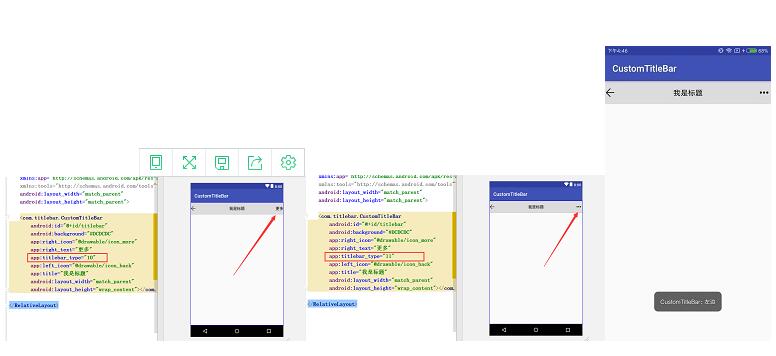本文实例为大家分享了Android实现简单顶部标题栏的具体代码,供大家参考,具体内容如下
实现功能:
1)自定义View标题栏布局;
2)灵活的可以自己传入类型,选择所需要的控件来显示隐藏
3)相对于我之前写过的一篇,免继承,可直接在布局里使用
4)直接可以在布局控件里设置属性
老规矩,上几张效果图:

由效果图可见,这个是可以根据传入type来控制,比较灵活的
下面就来实现以下步骤,最后我会贴上源码
1.创建一个布局文件,命名,layout_titlebar,来部署我们的标题栏样式,可以自定义更改,图片文件可暂时用自己的替代
<?xml version="1.0" encoding="utf-8"?><android.support.constraint.ConstraintLayout xmlns:android="http://schemas.android.com/apk/res/android" xmlns:app="http://schemas.android.com/apk/res-auto" xmlns:tools="http://schemas.android.com/tools" android:layout_width="match_parent" android:layout_height="50dp"> <ImageView android:id="@+id/iv_back" android:layout_width="30dp" android:layout_height="30dp" android:layout_marginLeft="20dp" android:src="@drawable/icon_back" app:layout_constraintBottom_toBottomOf="parent" app:layout_constraintTop_toTopOf="parent" /> <TextView android:id="@+id/tv_title" android:layout_width="wrap_content" android:layout_height="wrap_content" android:text="标题" android:textColor="#000" android:textSize="16sp" app:layout_constraintBottom_toBottomOf="parent" app:layout_constraintLeft_toLeftOf="parent" app:layout_constraintRight_toRightOf="parent" app:layout_constraintTop_toTopOf="parent" /> <TextView android:id="@+id/tv_more" android:layout_width="wrap_content" android:layout_height="wrap_content" android:text="更多" android:textColor="#000" android:textSize="16sp" app:layout_constraintBottom_toBottomOf="parent" app:layout_constraintRight_toRightOf="parent" app:layout_constraintTop_toTopOf="parent" /> <ImageView android:id="@+id/iv_more" android:layout_width="30dp" android:layout_height="30dp" android:src="@drawable/icon_more" app:layout_constraintBottom_toBottomOf="parent" app:layout_constraintRight_toRightOf="parent" app:layout_constraintTop_toTopOf="parent" /> </android.support.constraint.ConstraintLayout>
2.自定义View,继承自RelativeLayout,第3步贴上attr文件
import android.content.Context;import android.content.res.TypedArray;import android.util.AttributeSet;import android.view.LayoutInflater;import android.view.View;import android.widget.ImageView;import android.widget.RelativeLayout;import android.widget.TextView; /** * @Author : 张 * @Email : manitozhang@foxmail.com * @Date : 2018/9/19 * * 一个简单的自定义标题栏 */ public class CustomTitleBar extends RelativeLayout { private ImageView ivBack; private TextView tvTitle; private TextView tvMore; private ImageView ivMore; public CustomTitleBar(Context context, AttributeSet attrs) { super(context, attrs); initView(context,attrs); } //初始化视图 private void initView(final Context context, AttributeSet attributeSet) { View inflate = LayoutInflater.from(context).inflate(R.layout.layout_titlebar, this); ivBack = inflate.findViewById(R.id.iv_back); tvTitle = inflate.findViewById(R.id.tv_title); tvMore = inflate.findViewById(R.id.tv_more); ivMore = inflate.findViewById(R.id.iv_more); init(context,attributeSet); } //初始化资源文件 public void init(Context context, AttributeSet attributeSet){ TypedArray typedArray = context.obtainStyledAttributes(attributeSet, R.styleable.CustomTitleBar); String int leftIcon = typedArray.getResourceId(R.styleable.CustomTitleBar_left_icon, R.drawable.icon_back);//左边图片 int rightIcon = typedArray.getResourceId(R.styleable.CustomTitleBar_right_icon, R.drawable.icon_more);//右边图片 String rightText = typedArray.getString(R.styleable.CustomTitleBar_right_text);//右边文字 int titleBarType = typedArray.getInt(R.styleable.CustomTitleBar_titlebar_type, 10);//标题栏类型,默认为10 //赋值进去我们的标题栏 tvTitle.setText(title); ivBack.setImageResource(leftIcon); tvMore.setText(rightText); ivMore.setImageResource(rightIcon); //可以传入type值,可自定义判断值 if(titleBarType == 10){//不传入,默认为10,显示更多 文字,隐藏更多图标按钮 ivMore.setVisibility(View.GONE); tvMore.setVisibility(View.VISIBLE); }else if(titleBarType == 11){//传入11,显示更多图标按钮,隐藏更多 文字 tvMore.setVisibility(View.GONE); ivMore.setVisibility(View.VISIBLE); } } //左边图片点击事件 public void setLeftIconOnClickListener(OnClickListener l){ ivBack.setOnClickListener(l); } //右边图片点击事件 public void setRightIconOnClickListener(OnClickListener l){ ivBack.setOnClickListener(l); } //右边文字点击事件 public void setRightTextOnClickListener(OnClickListener l){ ivBack.setOnClickListener(l); }} 3.在res下的values下创建attr文件
<?xml version="1.0" encoding="utf-8"?><resources> <declare-styleable name="CustomTitleBar"> <attr name="title" format="string"/> <attr name="left_icon" format="reference"/> <attr name="right_icon" format="reference"/> <attr name="right_text" format="string"/> <attr name="titlebar_type" format="integer"/> </declare-styleable> </resources>
String是文字类型,references是图片类型,integer是数字类型
4.需要用到我们的这个顶部标题栏的话,就在当前布局引入
可以根据type传入的值来改变右边显示文字还是图片,可在自定义View自定义该type值
<com.titlebar.CustomTitleBar android:id="@+id/titlebar" android:background="#DCDCDC" app:right_icon="@drawable/icon_more" app:right_text="更多" app:titlebar_type="11" app:left_icon="@drawable/icon_back" app:title="我是标题" android:layout_width="match_parent" android:layout_height="wrap_content"></com.titlebar.CustomTitleBar>
5.可以获取它的id,来调用它的点击事件
CustomTitleBar titleBar = findViewById(R.id.titlebar); titleBar.setLeftIconOnClickListener(new View.OnClickListener() { @Override public void onClick(View v) { Toast.makeText(MainActivity.this, "左边", Toast.LENGTH_SHORT).show(); } }); 6.就这么多了,在这里贴上源码,小伙伴可以试试
Android灵活的自定义顶部标题栏
以上就是本文的全部内容,希望对大家的学习有所帮助,也希望大家多多支持VEVB武林网。
注:相关教程知识阅读请移步到Android开发频道。